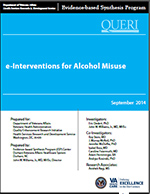
Investigators:
Eric Dedert, PhD
John W. Williams, Jr., MD, MHSc
Co-Investigators:
Roy Stein, MD;
J. Murray McNeil, PhD;
Jennifer McDuffie, PhD;
Isabel Ross, MD;
Caroline Feiermuth, MD;
Adam Hemminger, BA;
Andrjez Kosinski, PhD
Download PDF: Complete Report, Executive Summary, Report, Appendices
Alcohol misuse is the third leading cause of preventable death in the United States and the third leading cause of morbidity and mortality worldwide. The associated costs amount to more than 1% of the gross national product in high-and middle-income countries. Substance use disorders, including alcohol use disorder (AUD), are among the most common and most costly conditions in Veterans presenting for treatment in the Veterans Health Administration (VHA) system.
Traditional treatment for AUD—intensive, but time-limited initial interventions, then less intensive follow-up care—can be prohibitive because of barriers such as sufficient funding, time, and adequately trained personnel. Even screening and brief interventions for less severe alcohol misuse, which have been recommended by the U.S. Preventive Services Task Force (USPSTF), require financial and clinical resource investments that can be problematic. Thus, electronic interventions (e-interventions) may prove a useful way to extend the reach of traditional interventions for alcohol misuse or AUD.
Eighty-seven percent of the U.S. population uses the Internet. Thus, e-interventions have the potential to reach those individuals with drinking problems who wish to remain anonymous; those who live at great distance from, cannot afford, or have little time for traditional therapy; and shift workers who need treatment to be available during non-standard business hours. Given that Veterans can encounter most, if not all, of these barriers to accessing care for alcohol misuse, e-interventions may prove a promising new avenue, especially for the younger, more Internet-savvy Veterans returning from Iraq and Afghanistan.
Although prior reviews have evaluated computerbased interventions for alcohol misuse, our study includes a broader array of e-interventions, evaluates effects separately for student and non-student populations, and focuses on studies that report longer term, clinically important outcomes. In order to inform policy on alcohol misuse for VHA, we offer a systematic review of the randomized controlled trials (RCTs) assessing CD-ROM-based, web-based, interactive voice response (IVR), or mobile applications of e-interventions for alcohol misuse. We assess for changes in alcohol consumption, effects on medical health, and social or legal consequences of alcohol misuse.
Key Question #1: For e-interventions targeting adults who misuse alcohol or who have a diagnosis of AUD, what level, type, and modality of user support is provided (eg, daily telephone calls, weekly email correspondence), by whom (eg, professional counselor, technical support staff), and in what clinical context (adjunct to therapy or primary intervention)?
Key Question #2: For adults who misuse alcohol but do not meet diagnostic criteria for AUD, what are the effects of e-interventions compared with inactive controls?
Key Question #3: For adults at high risk of AUD (eg, AUDIT-C > 8), or who have a diagnosis of AUD, what are the effects of e-interventions compared with inactive controls?
Key Question #4: For adults who misuse alcohol, are at high risk of AUD, or have a diagnosis of AUD, what are the effects of e-interventions alone or used in combination with face-toface therapy compared with face-to-face therapy alone?